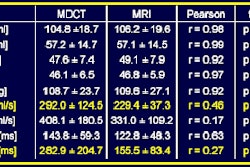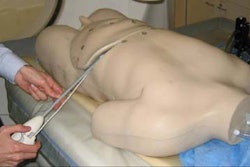Whether they were veteran workers or new to the job, a group of welders showed distinctive neurological changes on MR images, leading their physicians to diagnose manganese neurotoxicity. The doctors reported on these cases in Neurology.
"Although many elemental metals are released in welding fumes, the neurotoxicity is presumed to be primarily mediated by manganese," wrote Dr. Keith Josephs and colleagues from the Mayo Clinic in Rochester, MN. Josephs is from the department of neurology. His co-authors are from the department of psychiatry and the division of preventative and occupational medicine (Neurology, June 28, 2005, Vol. 64:12, pp. 2033-2039).
Manganese neurotoxicity commonly presents as parkinsonian syndrome, showing up on T1-weighted MR as an increased signal in the basal ganglia, particularly in the globus pallidus and the striatum.
Josephs' group saw eight patients, all male, who had put in anywhere from a year to 25 years as welders before their first neurologic symptoms. The patients had been referred to neurology with various complaints such as headache, imbalance, vertigo, and sleeplessness. They underwent a series of MR scans with sequences that included T1-weighted imaging with and without contrast, T2-weighted imaging, proton density-weighted imaging, and FLAIR and diffusion imaging, Josephs explained in an e-mail to AuntMinnie.com. The images were read by a Mayo neuroradiologist.
According to the results, the following clinical syndromes were recognized:
- Parkinsonian syndrome
- Syndrome of multifocal myoclonus and limited cognitive impairment
- Mixed syndrome with vestibular-auditory symptoms
- Minor syndrome with subjective cognitive impairment, anxiety, and sleep apnea
"In all eight cases, there was a bilateral hyperintense signal on T1-weighted MRI sequences in the globus pallidus," the authors stated. Including follow-up, six patients underwent multiple MR scans, and two had continued exposure indicated by an unchanged or increased T1 signal intensity. In one case, a second MR scan done six years after the patient had stopped welding revealed resolution of the abnormal pallidal T1 signal, they added.
A lack of proper ventilation during welding was the main reason behind manganese neurotoxicity, the authors suggested. None of the patients used personal respirators. One patient said that he wore a mask, but that his job required squeezing into tight spaces without any exhaust system.
Previous studies in welders have shown that the exposure time is not a factor for manganese neurotoxicity, Josephs explained in his e-mail. Novice welders were just as likely to suffer from neurological symptoms as older workers.
Although a logical assumption would be that safety standards are enforced to protect workers from this kind of damage, that wasn't necessarily the case, Josephs stated.
"Some welders disregarded (safety issues), but in most cases safety standards were not in place, especially if welding occurred at home or in a 'private/personal' business," he noted.
Josephs stated that his group planned to continue following these patients, both clinically and with imaging. "My hope is to be able to get enough funds to pursue PET imaging and neuropsychological testing, and to continue to follow their progression," he wrote.
By Shalmali Pal
AuntMinnie.com staff writer
June 29, 2005
Related Reading
Nailed in the head: X-ray, CT show patient's good luck, July 13, 2004
Part I: The back story on asbestos x-ray B readers, September 7, 2004
Part II: A survey of asbestos-related imaging, September 7, 2004
CT spots sentinel pneumonia in 9-11 rescue worker, September 25, 2002
Copyright © 2005 AuntMinnie.com



.fFmgij6Hin.png?auto=compress%2Cformat&fit=crop&h=100&q=70&w=100)




.fFmgij6Hin.png?auto=compress%2Cformat&fit=crop&h=167&q=70&w=250)











